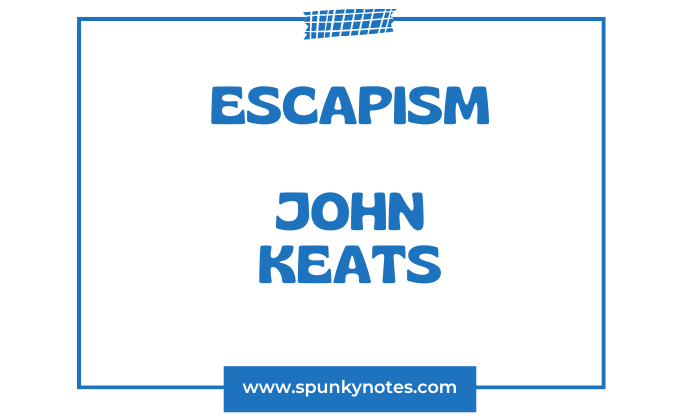

Estimated Reading Time: 7 min
Q. Write a note on escapism in John Keats Poetry.
Escapism in John Keats’ Poetry
John Keats’s escapism is about his wish to find peace and beauty away from the sadness and pain of the world. He looks for comfort in imagination, nature, and art.
This escape is a key feature of his poetry. It reflects the Romantic movement, which sought deeper meaning and peace outside the struggles of daily life.
As a famous poet of the Romantic era, Keats found meaning in the beauty of nature. He also found it in the power of imagination and the lasting nature of art.
His poetry often shows a desire to rise above human life’s sadness. Keats’s life was filled with personal losses and the constant reminder of death. These experiences profoundly influenced his writing and themes.
The young poet often wanted to escape the harsh reality of death and the human condition. This theme appears often in his odes.
Through his poetry, Keats creates a world. In this world, the lasting beauty of nature and art contrasts with the shortness of life.
Escapism in Ode to a Nightingale
In “Ode to a Nightingale,” Keats articulates a deep longing to dissolve into the carefree existence of the nightingale, whose song is both a reminder of the beauty of the world and a contrast to the pain of human life.
Poetic Escape
In “Ode to a Nightingale,” John Keats presents the idea of escapism through the nightingale’s song, which symbolizes a departure from the pains of human existence to a state of timeless beauty.
Fade far away, dissolve, and quite forget
What thou among the leaves hast never known,
The weariness, the fever, and the fret.
Keats expresses a wish to leave behind life’s physical suffering and mental anguish, something the nightingale, in its natural state, never experiences. This desire for escape is evident when he writes about wanting to fade away from the world’s troubles.
Eternal Escape
Thou wast not born for death, immortal Bird!
No hungry generations tread thee down
The poem suggests the nightingale’s song as an eternal escape. Keats contrasts the mortal human condition, marked by death and generational shifts, with the bird’s timeless song.
He views the bird’s melody as an entry to a realm beyond the limits of human life and death.
Escape Through Imagination
Away! away! for I will fly to thee,
Not charioted by Bacchus and his pards,
But on the viewless wings of Poesy.
Keats also imagines being transported to the nightingale’s presence not through physical means or mythical assistance but through the power of poetry and imagination.
This form of escape, rooted in creativity, offers relief from the difficulties of the material world.
Thus, “Ode to a Nightingale” links the theme of escapism directly with the act of creative expression and a deep appreciation of nature’s beauty through engaging with the natural world and imagination.
Keats finds a temporary respite from the sorrows of life, connecting with the enduring allure represented by the nightingale’s song.
Escapism in Ode on a Grecian Urn
“Ode on a Grecian Urn” further illustrates Keats’s escapism through his admiration for the eternal stillness and beauty captured on the urn.
The scenes frozen in time on the urn’s surface offer Keats a glimpse into a world where beauty is everlasting, and life’s troubles are absent.
Heard melodies are sweet, but those unheard
Are sweeter
It suggests that the music depicted on the urn, though silent and unheard in the physical world, transcends actual sound. This silent music symbolizes an idealized beauty.
It is perfect because it is imagined, not subject to the flaws and limitations of real music. This silent music is an escape into eternal beauty and perfection, impossible in the transient, imperfect world.
It is a beauty that exists in the mind’s eye. It remains untouched and unspoiled by the physical limitations of existence. Through these lines, Keats explores the idea that art can capture and preserve the essence of experience.
This essence is purer and more exquisite than anything real life can offer. The silent music becomes a metaphor for the ultimate escapism. It is where one finds solace and beauty in the eternal and immutable, as captured by art.
Escapism in Ode to Psyche
“Ode to Psyche” is an ode to the mind’s power to create its sanctuaries of beauty and peace. By dedicating an ode to Psyche, the goddess of the soul, Keats underscores the importance of the inner world as a refuge from external suffering.
The poet pledges to be Psyche’s priest and build her a sanctuary in the mind’s quiet spaces, highlighting imagination as a potent tool for escapism.
Yes, I will be thy priest, and build a fane
In some untrodden region of my mind,
Where branched thoughts, new grown with pleasant pain,
Instead of pines shall murmur in the wind:
In “Ode to Psyche,” John Keats highlights the concept of escapism not just as a simple withdrawal from reality, but as an intentional and creative effort to build a mental sanctuary.
This sanctuary, akin to a temple, is a place where beauty, peace, and the divine presence of Psyche can exist without interruption. Keats imagines unvisited areas of his mind as the site for this sanctuary.
He uses nature-inspired descriptions (like branching thoughts and whispering pines) to paint a picture of this space. This approach elevates using one’s imagination to a very special role, akin to a priest’s.
Here, the sanctuary serves both as a shelter and as evidence of the mind’s ability to create beauty and meaning even when confronted with difficult situations.
Keats’s escapism is not merely a flight from reality but an intricate dance between acceptance and desire, between facing life’s harsh truths and finding refuge in beauty and imagination.
His poetry does not deny the existence of pain and death but offers a counterpoint by highlighting the enduring nature of beauty, whether found in nature, art, or the human soul.
Through his odes, Keats invites readers to perceive the world with a more profound sensitivity to its beauty, suggesting that even in the face of mortality, there exists a timeless, ethereal world accessible through the imagination.
Conclusion
In conclusion, John Keats’s poetry shows his desire to escape life’s difficulties by finding beauty and peace in nature and art.
However, this escape is only temporary. Keats steps away from reality to find a moment of comfort and strength, but he always comes back to face everyday life with a renewed spirit.
This cycle of leaving and returning does not mean he wants to avoid reality altogether. Instead, it is a way to cope better with life’s challenges.
By the end of “Ode to a Nightingale,” the poet finds himself pulled back to reality:
Adieu! the fancy cannot cheat so well
As she is fam’d to do, deceiving elf.
Adieu! adieu! thy plaintive anthem fades.
These lines underscore the temporary nature of his escapism, emphasizing that one must return to face life’s realities after a brief respite.
Keats uses his moments of escape to gather energy and prepare to face life again. These breaks are not about giving up on the real world but finding balance. They help Keats and his readers appreciate life and handle its ups and downs more resiliently.
So, Keats’s approach to escaping reality is practical. Taking short breaks into the world of beauty and imagination can help us deal with life’s problems more effectively.
Keats teaches us that these pauses are essential for our mental and emotional well-being, making us more robust and prepared to move on with life.


